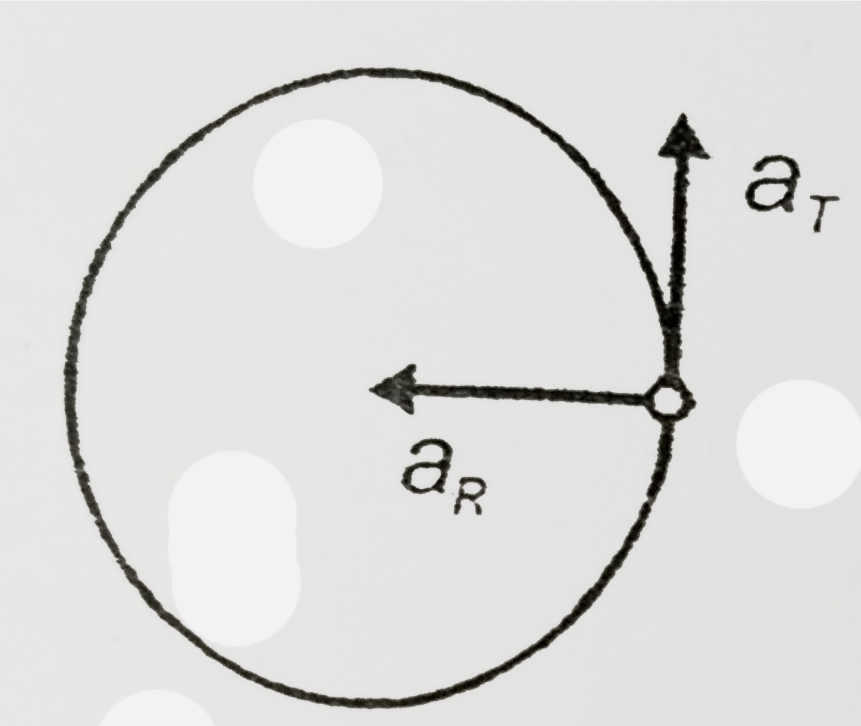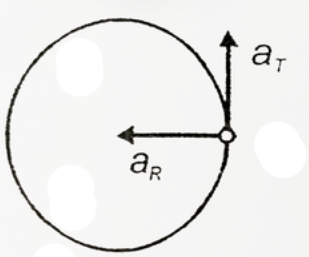A particle is moving on a circle of radius such that at every instant the tangential and radial accelerations are equal in magnitude. If the velocity of the particle be at , the time for the completion of the half of the first revolution will be
To solve the problem, we need to analyze the motion of a particle moving in a circular path with equal tangential and radial accelerations. Let's break down the solution step by step.
Step 1: Understanding the relationship between tangential and radial acceleration
Given that the tangential acceleration at is equal to the radial (centripetal) acceleration ar, we can express these accelerations as:
- Tangential acceleration: at=αR (where α is the angular acceleration)
- Radial acceleration: ar=v2R
Since at=ar, we have:
αR=v2R
This simplifies to:
α=v2R2
Step 2: Relating angular velocity and angular acceleration
The angular velocity ω is related to the linear velocity v by:
v=ωR
Differentiating v with respect to time gives:
dvdt=Rdωdt=Rα
Step 3: Setting up the differential equation
From the previous steps, we can substitute α:
dvdt=v2R
This can be rearranged to:
dvv2=dtR
Step 4: Integrating the equation
Integrate both sides:
∫dvv2=∫dtR
This results in:
−1v=tR+C
where C is the integration constant. At t=0, v=v0:
−1v0=C
Thus, we have:
−1v=tR−1v0
Rearranging gives:
1v=1v0−tR
Step 5: Finding the time for half a revolution
For half a revolution, the angle θ is π. The relationship between angular displacement and angular velocity is:
θ=∫ωdt
Using ω=vR and substituting v:
θ=∫R1v0−tRdt
This integral can be solved to find the time t for θ=π.
Step 6: Solving the integral
After performing the integration and substituting the limits, we can find that:
t=πRv0
Conclusion
Thus, the time for the completion of half of the first revolution is:
t=πRv0
Given that the tangential acceleration at is equal to the radial (centripetal) acceleration ar, we can express these accelerations as:
- Tangential acceleration: at=αR (where α is the angular acceleration)
- Radial acceleration: ar=v2R
αR=v2R
This simplifies to:
α=v2R2
The angular velocity ω is related to the linear velocity v by:
v=ωR
Differentiating v with respect to time gives:
dvdt=Rdωdt=Rα
From the previous steps, we can substitute α:
dvdt=v2R
This can be rearranged to:
dvv2=dtR
Integrate both sides:
∫dvv2=∫dtR
This results in:
−1v=tR+C
where C is the integration constant. At t=0, v=v0:
−1v0=C
Thus, we have:
−1v=tR−1v0
Rearranging gives:
1v=1v0−tR
For half a revolution, the angle θ is π. The relationship between angular displacement and angular velocity is:
θ=∫ωdt
Using ω=vR and substituting v:
θ=∫R1v0−tRdt
This integral can be solved to find the time t for θ=π.
After performing the integration and substituting the limits, we can find that:
t=πRv0
Thus, the time for the completion of half of the first revolution is:
t=πRv0
Topper's Solved these Questions
Similar Questions
a particle is moving in a circle of radius R in such a way that at any instant the normal and the tangential component of its acceleration are equal. If its speed at t=0 is v0 then time it takes to complete the first revolution is Rαv0(1−e−βπ). Find the value of (α+β).
View SolutionA particle is moving on a circle of radius A .At an instant its speed and tangential acceleration are B and C respectively.Total acceleration of the particle at that instant is
View SolutionA particle is moving in a circle of radius R in such a way that at any instant the normal and tangential component of the acceleration are equal. If its speed at t=0 is u0 the time taken to complete the first revolution is
View SolutionA particle moves with deceleration along the circle of radius R so that at any moment of time its tangential and normal acceleration are equal in moduli. At the initial moment t=0 the speed of the particle equals v0, then th speed of the particle as a function of the distance covered S will be
View SolutionA particle is moving along a circular path ofradius R in such a way that at any instant magnitude of radial acceleration & tangential acceleration are equal. 1f at t = 0 velocity of particle is V0. Find the speed of the particle after time t=(R)/(2V0)
View SolutionA particle moves with decreasing speed along the circle of radius R so that at any moment of time its tangential and centripetal accelerations are equal in magnitude. At the initial moment , t =0 its speed is u.

The magnitude of tangential acceleration at t=R2u isView SolutionA particle moves with decreasing speed along the circle of radius R so that at any moment of time its tangential and centripetal accelerations are equal in magnitude. At the initial moment , t =0 its speed is u.

The time after which the speed of particle reduces to half of its initial value isView SolutionA particle moves in a circle of radius 5 cm with constant speed and time period 0.2πs. The acceleration of the particle is
View SolutionA particle moves along a circle of radius r with constant tangential acceleration. If the velocity of the particle is v at the end of second revolution, after the revolution has started, then the tangential acceleration is
View SolutionA particle moves along a circle if radius (20 //pi) m with constant tangential acceleration. If the velocity of the particle is 80m/s at the end of the second revolution after motion has begun the tangential acceleration is .
View Solution

